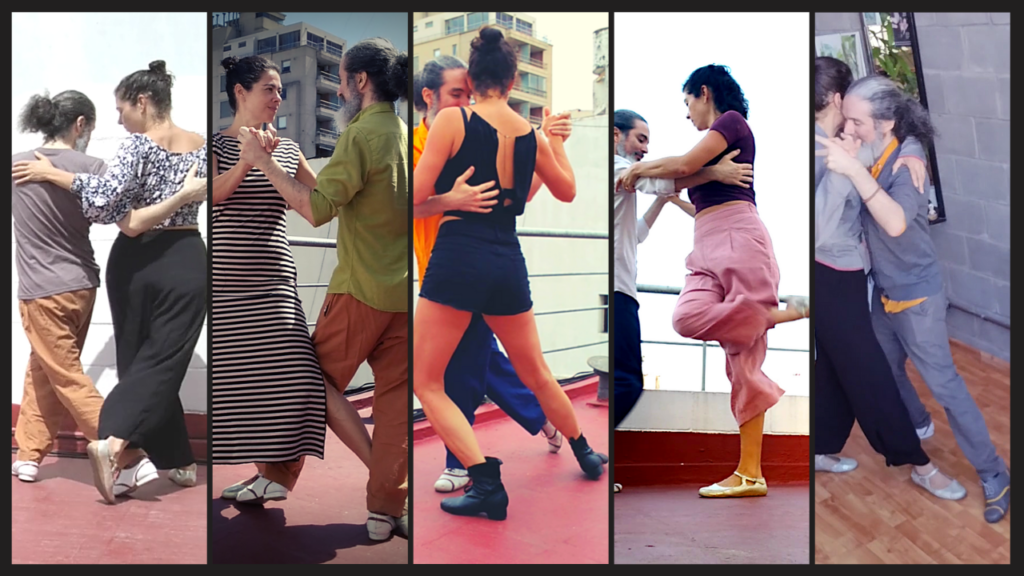Where does the Código de Giro come from?
Many forms of dance use this sequence of steps to navigate the dance floor; ballet dancers call it “pas de bourrée“, you can also found it in many folkloric dance. In Tango we know it as a code:
Open Step, Back Cross, Open Step, Front Cross, Open Step, Back Cross
You can see this code at the beginning of Tango, in Tango Canyengue.
The GIRO
To use the “Walking code / Código de marcha” (name coined by Gustavo Naveira) in a circular path, we need to add some pivots.
There is a convention for the walking code in a circular path, known in Tango as El Giro, which says :
A complete turn around a reference should be done in 4 steps.
To comply with this convention, we need to add 2 pivots to the walking code. Therefore the Turn Code / Código de Giro would look like this:
Back Cross, Open Step, Front Cross, Pivot, Open Step, Pivot
6 movements make up the Turn Code, 4 steps (complying with the convention) and 2 pivots.
There’s a difference between the steps and the pivots. In the steps we move towards a new place. In a pivot we keep our place, there is no displacement, only rotation.
The Half Turn / Medio Giro
We call to the combination of the three consecutive movements where there’s no pivots Half Turn / Medio Giro:
Back Cross, Open Step, Front Cross
The absence of a pivot makes it easier. Is the most used combination to start learning and teaching this code.
Analyzing the GIRO Code
When analyzing this Giro Code / Código de Giro, some interesting facts emerge:
- The displacement during the rotation is not uniform, since the Pivots are not displacement movements.
- The code can be started from any of its links.
- The number of Pivots and their position in the code is only kept for the 4-step convention for a full turn. When turning with fewer or more number of steps, more Pivots can appear.
- As long as we maintain the turning sense, we will cross with the same leg throughout the turn, and the other leg will always take the Open Steps. To change this relationship we will have to change the turning sense.
The Axis and the Circle
The Turn Code / Código de Giro is used to rotate around an axis or reference.
Where is the axis of the turn?
In a Tango couple there can be two situations:
- One person acts as an axis and the other as a circle turning around. Or..
- The two people turn around a shared axis that is located in the center of the couple.
The axis and the circle are not associated with any specific role of the couple.
In the first case, person who is stepping will establish the turning sense . The circle can turn clockwise or counterclockwise. The other person rotates on their own axis, without displacement in space.
In the second case, both people in the couple act as a circle. Both move with a circumference radius and a turning sense, which may or may not coincide.
When the radius and the turning sense of both coincide, the axis between them will remain fixed. The couple will rotate in the same place on the dance floor.
Otherwise, there are many situations that could arise but with something in common, the axis of the couple will start to move on the dance floor.
There is another possibility that always caught my attention. Thanks to this I can analyze ALL the movements of the couple as CIRCULAR.
You can create a linear movement with two circular movements.
Have you thought about it that way?
You can see on El Pasito that every movement with its name and turning sense to which that movement belongs.
Although the Turn Code seems to refer to something very structured and is generally learned by memory, there is a logical reasoning by which the same sequence of movements is reached. Performing a turn and a rotation simultaneously and considering the limits that the Tango embrace proposes.
I show this on this video :
This is an attempt to organize and put into words the information that I have been collecting for years in classes and researching. I hope you find it useful no matter at what stage of your journey you are.
Thanks for reading all the post ! All thoughts and comments are very welcome in the comment section down below.
My References about this subject :
- Gustavo Naveira
- Pablo Retamar
- Luciana Valle
- Martin Bel
Did you enjoy it ?
This article was intended to open discussion and share our ideas, experiences and research at the moment of writing it.
It’s a great exercise to write down ideas and thoughts, revisiting ideas, choosing the right words, keep it consistent and clear so everybody can understand and get something from it, even those ideas you think are totally “digested” already.
Will we continue to think the same in the future? We won’t know until that future arrives and we can compare it.



